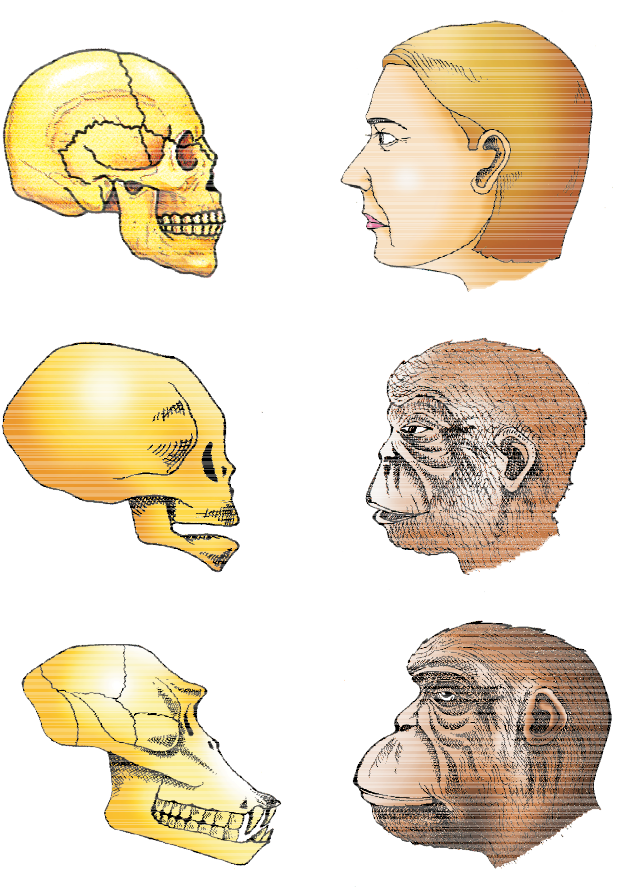About 15 mya, primates called Dryopithecus and Ramapithecus were existing. They were hairy and walked like gorillas and chimpanzees. Ramapithecus was more man-like while Dryopithecus was more ape-like. Few fossils of man-like bones have been discovered in Ethiopia and Tanzania (Figure 7.11). These revealed hominid features leading to the belief that about 3-4 mya, man-like primates walked in eastern Africa. They were probably not taller than 4 feet but walked up right. Two mya, Australopithecines probably lived in East African grasslands. Evidence shows they hunted with stone weapons but essentially ate fruit. Some of the bones among the bones discovered were different. This creature was called the first human-like being the hominid and was called Homo habilis. The brain capacities were between 650-800cc. They probably did not eat meat. Fossils discovered in Java in 1891 revealed the next stage, i.e., Homo erectus about 1.5 mya. Homo erectus had a large brain around 900cc. Homo erectus probably ate meat. The Neanderthal man with a brain size of 1400cc lived in near east and central Asia between 1,00,000-40,000 years back. They used hides to protect their body and buried their dead. Homo sapiens arose in Africa and moved across continents and developed into distinct races. During ice age between 75,000-10,000 years ago modern Homo sapiens arose. Pre-historic cave art developed about 18,000 years ago. One such cave paintings by Pre-historic humans can be seen at Bhimbetka rock shelter in Raisen district of Madhya Pradesh. Agriculture came around 10,000 years back and human settlements started. The rest of what happened is part of human history of growth and decline of civilisations.

Figure 7.11 A comparison of the skulls of adult modern human being, baby chimpanzee and adult chimpanzee. The skull of baby chimpanzee is more like adult human skull than adult chimpanzee skull
SUMMARY
The origin of life on earth can be understood only against the background of origin of universe especially earth. Most scientists believe chemical evolution, i.e., formation of biomolecules preceded the appearance of the first cellular forms of life. The subsequent events as to what happened to the first form of life is a conjectured story based on Darwinian ideas of organic evolution by natural selection. Diversity of life forms on earth has been changing over millions of years. It is generally believed that variations in a population result in variable fitness. Other phenomena like habitat fragmentation and genetic drift may accentuate these variations leading to appearance of new species and hence evolution. Homology is accounted for by the idea of branching descent. Study of comparative anatomy, fossils and comparative biochemistry provides evidence for evolution. Among the stories of evolution of individual species, the story of evolution of modern man is most interesting and appears to parallel evolution of human brain and language.
EXERCISES
1. Explain antibiotic resistance observed in bacteria in light of Darwinian selection theory.
NEETprep Answer
2. Find out from newspapers and popular science articles any new fossil discoveries or controversies about evolution.
NEETprep Answer
3. Attempt giving a clear definition of the term species.
NEETprep Answer
4. Try to trace the various components of human evolution (hint: brain size and function, skeletal structure, dietary preference, etc.)
NEETprep Answer
5. Find out through internet and popular science articles whether animals other than man has self-consciousness.
NEETprep Answer
6. List 10 modern-day animals and using the internet resources link it to a corresponding ancient fossil. Name both.
NEETprep Answer
7. Practise drawing various animals and plants.
NEETprep Answer
8. Describe one example of adaptive radiation.
NEETprep Answer
9. Can we call human evolution as adaptive radiation?
NEETprep Answer
10. Using various resources such as your school library or the internet and discussions with your teacher, trace the evolutionary stages of any one animal, say horse.
NEETprep Answer